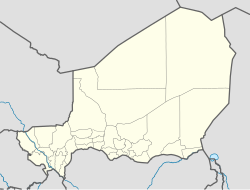Zinder
| Zinder | |
|---|---|

An ancient mudbrick home in the Birni old town
|
|
| Coordinates: 13°48′19″N 8°59′18″E / 13.80528°N 8.98833°ECoordinates: 13°48′19″N 8°59′18″E / 13.80528°N 8.98833°E | |
| Country |
|
| Region | Zinder |
| Department | Matameye |
| capital of Damagaram | 1736 |
| Elevation | 479 m (1,572 ft) |
| Population (2012) | |
| • Total | 256,000 |
Zinder (locally, Damagaram), formerly also spelled Sinder, is the second largest city in Niger, with a population of 170,574 (2001 census); by 2005 its population was estimated to be over 200,000. It is situated 861 km (535 mi) east of the capital Niamey and 240 km (150 mi) north of the Nigerian city of Kano.
Zinder rose from a small Hausa village to an important centre of the Trans-Saharan trade with the founding of the Sultanate of Damagaram in 1736 by Kanouri aristocrats. The large fortress of the southeast central city (Birini) was built shortly thereafter, and became a major hub for trade south through Kano and east to Bornu. The Tuareg encampments and trade houses of the suburb Zengou expanded with this trade.
In the 19th century, the area was originally subject to the Sultanate of Bornu but was fully independent by the time of Rabah's conquest of that state. The French explorer Cazemajou was killed in the city in 1897. It was then, after a brief resistance, occupied in July 1899 by Lt. Pallier of the Voulet-Chanoine mission. The French barracks was called Fort Cazemajou and it served as the capital of the Niger Military Territory upon its creation in 1911. In 1926, following fears of Hausa revolts and improving relations with the Djerma of the west, the capital was transferred back to the village of Niamey.
Upon Niger's independence from France, the town's fort was renamed Tanimoun, after a native sultan.
In 2003, telecommunications company Celtel arrived in Zinder, building a mobile phone tower and selling prepaid phone cards to residents. This arrival of the mobile phone drastically changed the predominant modes of communication in the city, allowing traders to have a faster and more affordable means of communicating with buyers and sellers. This is an example of how cellular towers in the developing world have begun to transform the market.
...
Wikipedia

